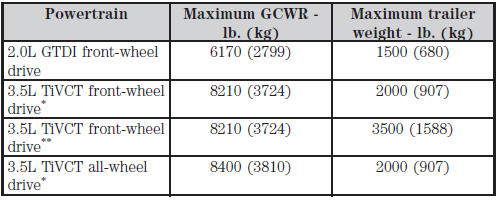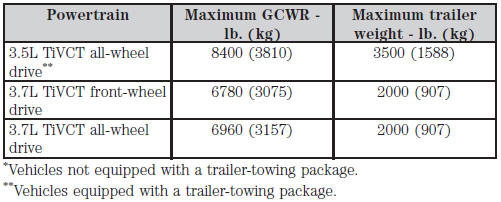Towing
Trailer towing
WARNING: Do not exceed the GVWR or the GAWR specified on the certification label.
WARNING: Towing trailers beyond the maximum recommended gross trailer weight exceeds the limit of your vehicle and could result in engine damage, transmission damage, structural damage, loss of vehicle control, vehicle rollover and personal injury.
Note: For information on electrical items such as fuses or relays, see the Fuses chapter.
Your vehicle’s load capacity designation is by weight, not by volume, so you cannot necessarily use all available space when loading a vehicle.
Towing a trailer places an extra load on your vehicle’s engine, transmission, axle, brakes, tires and suspension. Inspect these components periodically during, and after, any towing operation.
Load Placement
To help minimize how trailer movement affects your vehicle when driving:
• Load the heaviest items closest to the trailer floor.
• Load the heaviest items centered between the left and right side trailer tires.
• Load the heaviest items above the trailer axles or just slightly forward toward
the trailer tongue. Do not allow the final trailer tongue weight to go above or
below 10–15% of the loaded trailer weight.
• Select a tow bar with the correct rise or drop. When both the loaded vehicle and
trailer are connected, the trailer frame should be level, or slightly angled down
toward your vehicle, when viewed from the side.
When driving with a trailer or payload, a slight takeoff vibration or shudder may be present due to the increased payload weight. You can find more information about proper trailer loading and setting your vehicle up for towing under Load limit in the Load Carrying chapter and in the RV & Trailer Towing Guide, available at an authorized dealer.
TRAILER SWAY CONTROL (IF EQUIPPED)
Note: This feature does not prevent trailer sway, but reduces it once it begins.
Note: This feature cannot stop all trailers from swaying.
Note: In some cases, if vehicle speed is too high, the system may turn on multiple times, gradually reducing vehicle speed.
This feature applies your vehicle brakes at individual wheels and, if necessary, reduces engine power. If the trailer begins to sway, the stability control light flashes and the message TRAILER SWAY REDUCE SPEED appears in the information display. The first thing to do is slow your vehicle down, then pull safely to the side of the road and check for proper tongue load and trailer load distribution. See the Load Carrying chapter for specific loading information.
RECOMMENDED TOWING WEIGHTS
Note: Do not exceed the trailer weight for your vehicle configuration listed in the chart below.
Note: Make sure to take into consideration trailer frontal area. Do not exceed 30 feet2 (2.79 meters2) trailer frontal area.
Note: For high altitude operation, reduce the gross combined weight by 2% per 1000 feet (300 meters) starting at the 1000 foot (300 meter) elevation point.
Note: Certain states require electric trailer brakes for trailers over a specified weight. Be sure to check state regulations for this specified weight. The maximum trailer weights listed may be limited to this specified weight, as your vehicle’s electrical system may not include the wiring connector needed to use electric trailer brakes.
Your vehicle may tow a Class I or III trailer provided the maximum trailer weight is less than or equal to the maximum trailer weight listed for your vehicle configuration on the following chart.


ESSENTIAL TOWING CHECKS
Follow these guidelines for safe towing:
• Do not tow a trailer until you drive your vehicle at least 1000 miles (1600
kilometers).
• Consult your local motor vehicle laws for towing a trailer.
• See the instructions included with towing accessories for the proper installation
and adjustment specifications.
• Service your vehicle more frequently if you tow a trailer. See your scheduled
maintenance information.
• If you use a rental trailer, follow the instructions the rental agency gives you.
For load specification terms found on the tire label and Safety Compliance label and for instructions on calculating your vehicle’s load, refer to Load limit in the Load Carrying chapter.
Remember to account for the trailer tongue weight as part of your vehicle load when calculating the total vehicle weight.
Trailer Towing Connector (Vehicles Equipped with a Trailer-towing or Prep Package)
The trailer towing connector is located under the rear bumper, on the left side of your vehicle.

Hitches
Do not use a hitch that either clamps onto the bumper or attaches to the axle.
Distribute the trailer load so 10-15% of the total trailer weight is on the tongue.
Safety Chains
Note: Never attach safety chains to the bumper.
Always connect the safety chains to the hook retainers of your vehicle hitch.
To connect the safety chains, cross them under the trailer tongue and allow enough slack for turning tight corners. Do not allow the chains to drag on the ground.
Trailer Brakes
WARNING: Do not connect a trailer’s hydraulic brake system directly to your vehicle’s brake system. Your vehicle may not have enough braking power and your chances of having a collision greatly increase.
Electric brakes and manual, automatic or surge-type trailer brakes are safe if you install them properly and adjust them to the manufacturer’s specifications. The trailer brakes must meet local and federal regulations.
The rating for the tow vehicle’s braking system operation is at the gross vehicle weight rating, not the gross combined weight rating.
Separate functioning brake systems are required for safe control of towed vehicles and trailers weighing more than 1500 pounds (680 kilograms) when loaded.
Trailer Lamps
WARNING: Never connect any trailer lamp wiring to the vehicle’s tail lamp wiring; this may damage the electrical system resulting in fire. Contact your authorized dealer as soon as possible for assistance in proper trailer tow wiring installation. Additional electrical equipment may be required.
Trailer lamps are required on most towed vehicles. Make sure all running lights, brake lights, turn signals and hazard lights are working.
Before Towing a Trailer
Practice turning, stopping and backing up to get the feel of your vehicle-trailer combination before starting on a trip. When turning, make wider turns so the trailer wheels clear curbs and other obstacles.
When Towing a Trailer
• Do not drive faster than 70 mph (113 km/h) during the first 500 miles (800
kilometers).
• Do not make full-throttle starts.
• Check your hitch, electrical connections and trailer wheel lug nuts thoroughly
after you have traveled 50 miles (80 kilometers).
• When stopped in congested or heavy traffic during hot weather, place the gearshift
in position P to aid engine and transmission cooling and to help A/C performance.
• Turn off the speed control with heavy loads or in hilly terrain. The speed control
may turn off automatically when you are towing on long, steep grades.
• Shift to a lower gear when driving down a long or steep hill. Do not apply the
brakes continuously, as they may overheat and become less effective.
• If your transmission is equipped with a Grade Assist or Tow/Haul feature, use
this feature when towing. This provides engine braking and helps eliminate excessive
transmission shifting for optimum fuel economy and transmission cooling.
• Allow more distance for stopping with a trailer attached. Anticipate stops and
brake gradually.
• Avoid parking on a grade. However, if you must park on a grade:
1. Turn the steering wheel to point your vehicle tires away from traffic flow.
2. Set your vehicle parking brake.
3. Place the automatic transmission in position P or manual transmission in a high
gear.
4. Place wheel chocks in front and back of the trailer wheels.
(Chocks not included with vehicle.)
Launching or Retrieving a Boat or Personal Watercraft (PWC)
Note: Disconnect the wiring to the trailer before backing the trailer into the water.
Note: Reconnect the wiring to the trailer after the trailer is removed from the water.
When backing down a ramp during boat launching or retrieval:
• Do not allow the static water level to rise above the bottom edge of the rear
bumper.
• Do not allow waves to break higher than 6 inches (15 centimeters) above the bottom
edge of the rear bumper.
Exceeding these limits may allow water to enter vehicle components:
• Causing internal damage to the components.
• Affecting driveability, emissions, and reliability.
Replace the rear axle lubricant anytime the rear axle has been submerged in water. Water may have contaminated the rear axle lubricant, which is not normally checked or changed unless a leak is suspected or other axle repair is required.
See also:
Under hood overview
2.0L EcoBoost® Engine
A. Engine coolant reservoir
B. Brake fluid reservoir
C. Battery
D. Power distribution box
E. Air filter assembly
F. Engine oil filler cap
G. Engine oil dipstick
H. Win ...
Vehicle loading – with and without a trailer
This section will guide you in the proper loading of your vehicle and/or trailer,
to keep your loaded vehicle weight within its design rating capability, with or
without a trailer. Properly loadin ...
Normal scheduled maintenance and log
Intelligent Oil-Life Monitor®
Your vehicle is equipped with an Intelligent Oil-Life Monitor® that determines
when the engine oil needs to be changed based on how your vehicle is used. By using
...
